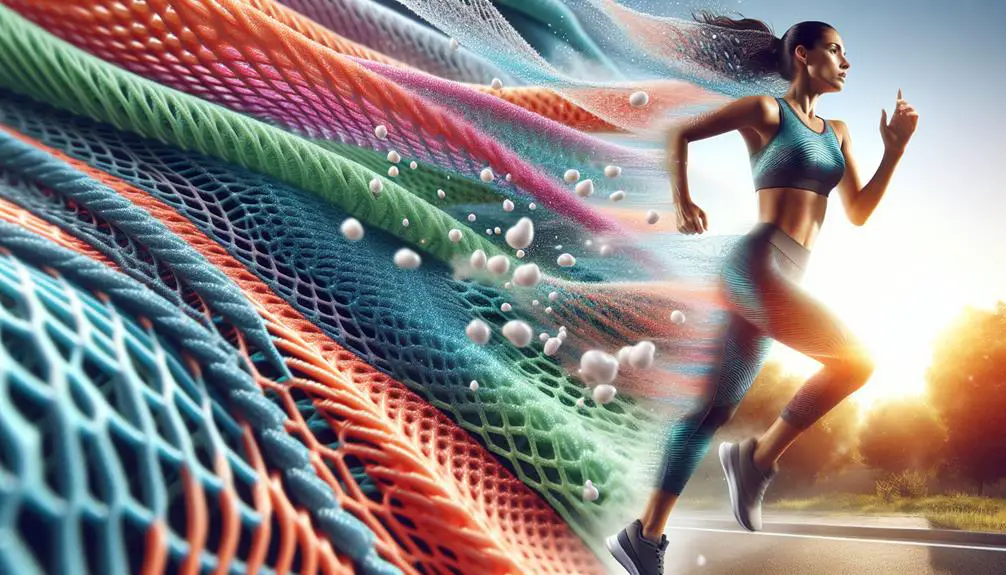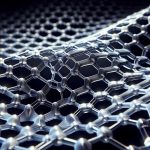You've likely heard about moisture-wicking fabrics, but do you know how much they've evolved? With the introduction of graphene-enhanced fibers and biopolymer-based textiles, these materials now offer superior thermal regulation and moisture management. Imagine your workout gear not only keeping you dry but also adjusting to your body's needs in real-time. Plus, there's a shift towards eco-friendly options like bamboo and recycled polyester, making sustainable high-performance gear a reality. What's driving these advancements, and how do they impact both performance and sustainability? Let's explore the cutting-edge innovations shaping this field.
Table of Contents
Key Takeaways
- Graphene-enhanced fibers and biopolymer-based textiles improve thermal regulation and moisture management.
- Enhanced fabric blends efficiently wick sweat away, ensuring superior dryness and comfort.
- Smart textiles embedded with sensors provide real-time adjustments to body temperature.
- Eco-friendly fibers like bamboo and recycled polyester offer sustainable moisture-wicking properties.
- Nanotechnology advancements enhance fabric durability and moisture-wicking capabilities.
Innovative Fiber Technologies
How have recent breakthroughs in fiber engineering revolutionized moisture-wicking fabrics?
You're now witnessing a transformation driven by cutting-edge materials and sustainable solutions that elevate performance and comfort to unprecedented levels. Engineers have innovated fibers that not only wick moisture more effectively but also maintain the integrity and durability of the fabric.
Cutting-edge materials like graphene-enhanced fibers and biopolymer-based textiles are game changers. Graphene, known for its exceptional strength and conductivity, has been incorporated into fibers to enhance thermal regulation and moisture management.
Imagine a fabric that adapts to your body's needs, keeping you cool when it's hot and warm when it's cold, all while efficiently moving sweat away from your skin.
Sustainable solutions are equally important in this revolution.
You're looking at fabrics made from recycled plastics and organic materials that don't compromise performance. These eco-friendly fibers are designed to minimize environmental impact while offering superior moisture-wicking capabilities.
The focus on sustainability guarantees that your high-performance gear is also kind to the planet.
Enhanced Fabric Blends
You'll find that enhanced fabric blends combine innovative fibers for superior moisture management.
These blends improve comfort levels by efficiently wicking sweat away from your skin.
As a result, you stay dry and comfortable during any activity.
Innovative Fiber Combinations
With the advent of innovative fiber combinations, moisture-wicking fabrics have reached new levels of performance and comfort. By integrating customized blends, manufacturers are creating high tech textiles that offer superior breathability and sustainability. You can now enjoy fabrics that not only keep you dry but also consider environmental impact.
These customized blends often incorporate materials such as recycled polyester and organic cotton, resulting in fabrics that align with sustainable practices. This fusion not only enhances your athletic performance but also contributes to a more eco-friendly lifestyle.
| Fiber Combination | Key Benefit |
|---|---|
| Recycled Polyester + Cotton | Sustainability |
| Nylon + Spandex | Stretch & Comfort |
| Merino Wool + Tencel | Breathability & Softness |
High tech textiles like these have been engineered to perform under intense conditions. Nylon and spandex blends, for instance, offer unparalleled stretch and comfort, making them ideal for activewear. Meanwhile, combinations like Merino wool and Tencel provide exceptional breathability and softness, perfect for casual and performance wear alike.
Superior Moisture Management
Building on these innovative fiber combinations, enhanced fabric blends elevate moisture management to new heights. You'll experience unparalleled performance thanks to these advanced materials. With a breathable construction, these fabrics guarantee that air circulates freely, keeping you cool and dry. This feature is essential for maintaining ideal body temperature during intense activities.
The quick drying capabilities of these blends are nothing short of remarkable. They're engineered to rapidly wick sweat away from your skin and disperse it across the fabric's surface. This promotes faster evaporation, so you're not left feeling damp or uncomfortable. The superior sweat absorption properties of these fabrics mean that even during the most strenuous workouts, moisture is quickly managed and your skin remains dry.
Odor control is another key benefit of these enhanced blends. They incorporate antimicrobial treatments that inhibit the growth of odor-causing bacteria. This guarantees that you stay fresh, even after prolonged wear. By mastering the balance of sweat absorption and odor control, these fabrics provide a consistently clean and comfortable experience.
With these advancements in moisture management, you'll achieve peak performance without compromising on comfort or hygiene.
Improved Comfort Levels
Enhanced fabric blends redefine comfort levels by offering a soft, seamless feel against your skin. Imagine wearing a garment that not only fits perfectly but also keeps you cool and dry, thanks to enhanced breathability and quick drying technology.
These advanced blends are designed to wick moisture away from your body efficiently, ensuring that you stay comfortable even during intense physical activities. You'll notice how the fabric adapts to your movements, providing a barely-there sensation that elevates your overall experience.
But it's not just about immediate comfort; these fabrics are built to last. With increased durability, they withstand frequent washing and wear without losing their shape or effectiveness. You won't have to worry about your favorite athletic gear breaking down after a few uses.
Additionally, odor resistance is a key feature in these enhanced blends. By incorporating advanced antimicrobial properties, the fabrics prevent the buildup of unpleasant smells, keeping you fresh throughout the day.
Eco-Friendly Options
Eco-friendly moisture-wicking fabrics are revolutionizing the textile industry by combining sustainability with high performance. When you choose these fabrics, you're not just selecting for superior moisture management but also making a conscious decision to support the environment. Sustainable materials and biodegradable options are at the forefront of this innovation.
- Sustainable Materials:
Fabrics like bamboo, organic cotton, and recycled polyester offer moisture-wicking properties while lessening environmental impact.
- Biodegradable Options:
Materials such as Tencel and merino wool decompose naturally, making sure they don't add to landfill waste.
- Eco-Conscious Manufacturing:
Many brands now employ eco-conscious manufacturing techniques, concentrating on reducing water and energy consumption.
- Chemical-Free Processes:
Choosing chemical-free processes not only safeguards the planet but also guarantees the fabric is safe against your skin.
Smart Fabric Integration
Imagine your workout clothes monitoring your heart rate and regulating your body temperature.
With smart fabric integration, embedded sensor technology and temperature regulation systems are transforming how you experience performance gear.
You're not just wearing fabric; you're interacting with advanced technology.
Embedded Sensor Technology
Embedded sensor technology in moisture-wicking fabrics is revolutionizing how we monitor and interact with our clothing. By integrating sensors directly into the fabric, you're not just wearing clothes, but a smart system that offers real-time data and feedback. This sensor integration elevates fabric intelligence, enabling your garments to collect and analyze information about your physiological state and environment.
Imagine your shirt doing the following:
- Monitoring your heart rate: Sensors woven into the fabric track your cardiovascular health, providing insights during workouts and daily activities.
- Measuring sweat levels: The fabric detects moisture, alerting you when hydration levels drop or when it's time to cool down.
- Tracking movement: Embedded accelerometers and gyroscopes analyze your posture and activity, helping optimize performance and prevent injuries.
- Analyzing environmental conditions: Sensors detect temperature and humidity, helping you adapt to changing conditions without the need for manual adjustments.
With these capabilities, you're empowered to stay ahead of your health and fitness goals.
These advancements in fabric intelligence mean your clothes aren't just passive wearables but active participants in your well-being, offering a seamless blend of technology and comfort.
Temperature Regulation Systems
Through advanced temperature regulation systems, smart fabrics can adjust to your body's needs, ensuring ideal comfort in varying conditions.
Imagine you're in the middle of an intense workout; your smart fabric gear detects your rising body temperature and activates its thermal regulation features. By enhancing sweat evaporation, these fabrics provide a cooling effect that keeps you comfortable and efficient.
You don't have to worry about overheating or getting too cold. The integration of micro-sensors and adaptive materials allows the fabric to respond dynamically. When your body heat rises, the fabric's cooling mechanism kicks in, accelerating sweat evaporation. Conversely, when the temperature drops, the smart fabric can trap heat to maintain a stable body temperature.
The precision of these temperature regulation systems is unmatched. They're not just reactive but proactive, anticipating your needs based on environmental conditions and your activity levels.
This seamless interaction between your body and the fabric enhances performance and comfort, whether you're an athlete, an outdoor enthusiast, or someone who values cutting-edge textile technology.
Mastering this innovation means you're always one step ahead, enjoying excellent thermal regulation no matter the challenge.
Performance Testing
To evaluate the effectiveness of moisture-wicking fabrics, rigorous performance testing is necessary. You need to assess several key factors to guarantee the fabric meets high standards.
First and foremost, fabric breathability plays a pivotal role in overall comfort. Testing involves measuring how well air flows through the material, which directly impacts moisture absorption and wearer experience.
Next, focus on moisture absorption. This test determines how quickly and efficiently the fabric pulls sweat away from your skin. High absorption rates are essential for maintaining dryness and preventing chafing during intense activities.
Third, evaluate sweat evaporation. Moisture-wicking fabrics mustn't only absorb sweat but also facilitate its rapid evaporation. By doing so, they keep you dry and comfortable. The faster the evaporation rate, the better the fabric performs.
Finally, consider heat dissipation. Effective moisture-wicking fabrics help regulate body temperature by dispersing heat. This guarantees you stay cool, even during the most strenuous activities.
Here's a quick summary of the key factors involved in performance testing:
- Fabric breathability
- Moisture absorption
- Sweat evaporation
- Heat dissipation
Future Trends
As technology continues to evolve, you can expect significant innovations in moisture-wicking fabrics that enhance performance and comfort. Smart textiles are at the forefront of this revolution. Imagine fabrics embedded with sensors that not only wick moisture but also monitor your essentials and adjust their properties in real-time. These advanced materials will give you unprecedented control over your athletic and daily wear, ensuring ideal conditions regardless of the environment.
Sustainable innovations are also transforming the landscape of moisture-wicking fabrics. You'll see an increasing focus on eco-friendly materials and manufacturing processes that minimize environmental impact. For example, companies are developing moisture-wicking fabrics from recycled plastics and organic fibers, reducing waste and conserving resources. These sustainable textiles won't just keep you dry; they'll also contribute to a healthier planet.
Moreover, advancements in nanotechnology are set to revolutionize fabric treatments, making them more durable and effective. You'll benefit from garments that maintain their moisture-wicking properties over time, even after countless washes.
As you continue to seek mastery in your pursuits, these future trends will provide you with the high-performance, sustainable options you need to excel.
Frequently Asked Questions
How Should I Wash Moisture-Wicking Fabrics?
To guarantee proper fabric care and maintenance, follow these washing instructions: Use cold water, a gentle cycle, and mild detergent. Avoid fabric softeners and high heat. These tips will help keep your moisture-wicking fabrics in top condition.
Are Moisture-Wicking Fabrics Safe for Sensitive Skin?
Did you know that 70% of people with sensitive skin report fewer reactions with moisture-wicking fabrics? If skin reactions occur, consider alternatives. Proper fabric care and gentle detergents also help maintain fabric's benefits and comfort.
Do Moisture-Wicking Fabrics Provide UV Protection?
You're wondering if moisture-wicking fabrics offer UV protection. Yes, they often do, but UV protection effectiveness depends on material composition. Look for fabrics specifically designed with UV-blocking properties for the best defense against harmful rays.
Can Moisture-Wicking Fabrics Be Used for Winter Clothing?
Yes, you can use moisture-wicking fabrics for winter clothing. They enhance winter performance by keeping you dry and warm. Layering options with moisture-wicking materials guarantee effective temperature regulation and comfort during cold weather activities.
How Long Do Moisture-Wicking Properties Last?
How long do moisture-wicking properties last? To truly understand the durability of moisture wicking, you must consider effectiveness over time. Proper maintenance tips can greatly enhance the longevity of properties, ensuring your gear stays effective.
- How Does Ring Spun Cotton Affect Garment Fit and Shape Retention? - August 13, 2024
- What Are the Challenges in Producing Ring Spun Cotton? - August 13, 2024
- Is Ring Spun Cotton Suitable for Plus-Size Clothing? - August 13, 2024







